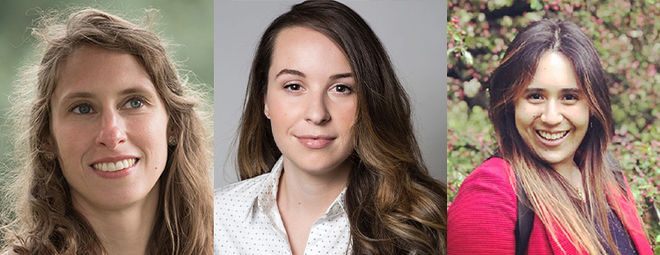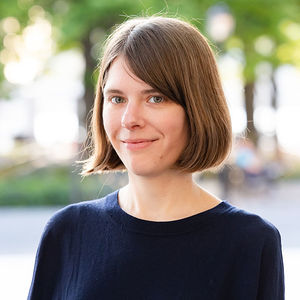
L to R: Julia Lillie, Julie Bellemare, Juliana Fagua Arias (Not Pictured: Nicole Pulichene)
The Metropolitan Museum of Art awards 50 fellowships each year to junior scholars, postdoctoral and senior academics, and museum professionals for independent study or research. This year, Bard Graduate Center (BGC) alumni and students hold four of those fellowships. Nicole Pulichene (MA ‘13) has a two-year-long postdoctoral fellowship in the Department of Medieval Art and the Cloisters; Julie Bellemare (PhD ’21) is the Jane and Morgan Whitney Postdoctoral Fellow in the Met’s Asian Art Department; Juliana Fagua Arias (MA ’21) is a Tiffany & Co. Foundation Curatorial Fellow in the American Wing; and Julia Lillie (MA ‘14 and current PhD candidate) is a Jane and Morgan Whitney Fellow in the Department of Drawings and Prints. These fellows have the opportunity to pursue the research interests they developed at BGC and to learn the ropes of working within a large and prestigious institution such as the Met. We checked in with them to learn more about the Met fellowship experience.
While at BGC, Pulichene focused on the material culture of European and Mediterranean contact regions. Now in the second year of her fellowship, which began in October of 2020, she is helping to reconceptualize displays and develop new publishing initiatives for the Department of Medieval Art’s permanent collection of late antique and medieval ivories from this area. This work includes the creation of a comprehensive catalog for which she developed an article (currently under review) focusing on a pair of ivory diptychs within the collection. She has also been helping to catalog the Department’s carved bone collection.
Bellemare completed her dissertation on the development of new enamel colorants in Qing China at the turn of the eighteenth century. At the Met, she is studying the patterns of production and aesthetic appreciation of agates at the Qing court—a topic she became interested in while doing archival research in Taiwan and China for her PhD. She has been able to map historical agate mining sites in China thanks to the Met’s library resources, which provide access to rare books and online databases. She has also handled and examined about thirty agate objects from the collection with curator and BGC doctoral candidate Pengliang Lu. Bellemare believes that “a comprehensive study of agate carvings produced in the Qing dynasty will help contribute research to an overlooked category while making a significant contribution to the histories of Qing art and material culture.”
Fagua Arias graduated from BGC’s MA program last spring. As an MA, she researched the impact of early modern transnational networks (specifically the transpacific trade) on the material culture produced by Indigenous and Mestizo artisans in Mexico, Peru, and Colombia. At the Met, she conducts research for temporary exhibitions and permanent collection acquisitions with the curators of the American Wing, curates a rotation of drawings by Louis C. Tiffany, updates the collection’s database, and writes object labels. The fellowship also provides her with funding for independent research, which she may use to travel to Mexico City and Puebla. She said, “I have enjoyed getting to know the Museum’s staff and understanding the role of every department in this huge institution. People have been very welcoming, warm, and excited about what I can bring. I also enjoy working on projects that I will see finalized during my internship.”
Lillie, a current BGC PhD candidate and MA alumna, is using the Met’s collections to research the final chapter of her dissertation, which focuses on the social networks and oeuvres of Netherlandish printmakers who emigrated to Cologne, Germany in the late sixteenth century, specifically Frans Hogenberg, Crispijn de Passe, Matthias Quad, Jan Sadeler, and Adriaan de Weerdt. “I look at a wide variety of material, including mythological images, religious prints, maps, atlases, popular broadsheets, illustrated books, and contemporary historical texts. The Met’s collection of Northern European works on paper is incredibly rich, so it’s really informing all aspects of my thesis.”
Mackensie Griffin is a second-year BGC MA student.

